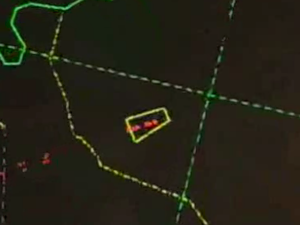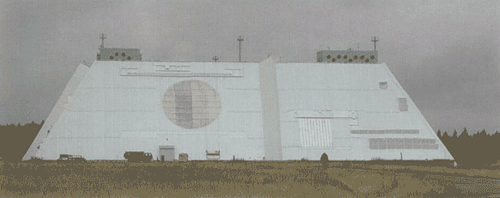SPRN - Missile Assault Warning System

January 23, 1995, the city of Solnechnogorsk, command post of MNS. The “ROCKET ATTACK” board caught fire on the system monitoring console. The system recorded the launch of a Trident class rocket. Analysis of the trajectory showed that the rocket, when activated at high altitude, could disable early warning systems of the early warning system out of service or could be aimed at the northern cities of the country. Ground early warning systems confirmed launch. All strategic forces were brought to full alert. Bombers roll out to the runway, missiles are pointed and ready to launch. On the table in front of the President of the country opened a nuclear briefcase.
The Supreme Commander immediately contacted the Minister of Defense. But the Minister of Defense, as a good military specialist, immediately determined that this could not be the beginning of the 3rd World War. If they had decided to attack us, they would have begun not with one rocket, but immediately from a hundred. One rocket does nothing.
Later it turned out that the system reacted to the launch of a Norwegian meteorological satellite, information about which was lost in the offices of the Ministry of Foreign Affairs. This was the first use of the Kazbek system, known as the nuclear briefcase.
The EWS system has been used for about 30 years and it did not have any failures. Many say that in 1985, the system also gave a signal of an attack, but then she herself acknowledged that the goals were false, so this cannot be considered a failure. The system is very complex and is still on alert.
History of creation
In 1961, the Americans tested a new Intercontinental Ballistic Missile "Minuteman-1", which opened a new nuclear missile phase of the Cold War. This missile had multiple warheads and camouflage systems.
For a long time, the USSR created a missile defense system, which, as it turned out, is absolutely useless against new missiles. It was necessary to develop a new system to counter the looming threat. The Minister of Defense issued an order for all prominent scientists to be brought to one place where they could develop a new concept of protection against a nuclear strike.
After 4 weeks the document was ready. Initially, two options for the development of systems to counter the threat were considered:
1. Response tactics. The strike on the enemy was carried out after hitting his missiles. This approach required a steady increase in the number of launchers and their strengthening. But this was a dead end, as with each generation of missiles their accuracy increased, which required building deeper and more secure bunkers and launch complexes. Therefore, the choice was stopped on a different approach.
2. Strike back. This approach meant that the release of missiles from mines should be made during the flight of enemy missiles. Consequently, the country needed a missile launch detection system.
According to military experts, such a system should consist of several components:
1. Space, whose task is to detect the launch of rockets and determine the country of the aggressor.
2. Ground based on the perimeter of the country by ground-based radar stations. With their help, the threat of attack is finally confirmed.
Space component.

Eye system
The main developer of the Central Research Institute "Comet".
The system consists of 12 satellites in high-elliptical orbits.
At the same time, 2 satellites should observe the territory of a potential enemy.
Satellites have on board video and infrared missile torch detection complex. The approval of the construction of such a system was due to the case. A satellite with an infrared detection complex was launched into low orbit. From the cosmodrome the rocket was supposed to start, the launch of which was to determine the satellite. But the launch was postponed and did not report this to the satellite designer. After receiving data from orbit, the designer concluded that the launch was about what he reported to the management. He was ridiculed. But the designer was confident in the equipment and drove to the cosmodrome. He was confirmed that the rocket did not start, but he also found out that a jet plane was warming up the engines not far from the cosmodrome on the runway. After completing the necessary calculations, it was concluded that it was in a highly elliptical orbit, which is 36,000 km high. the satellite will perform its tasks, which served as the start of the deployment of the Eye system.
In 1979, 4 satellites were launched into orbit. By 1982, 2 more, and the system was put on combat duty.
')
Eye-1 system
The logical continuation of the Eye system. The main developer of the Central Research Institute "Comet".
The satellites of this system were to be located in geostationary orbits. The deployment of the system began in 1991. From 1991 to 2008, 7 satellites were launched. In 1996, the system was put into service and put on combat duty.
CEN system
Unified space system. Trials began in 2009. How many satellites were put into orbit is not reliably known. The system involves the integration into a single complex of Oko, Oko-1 and new satellites systems.
Current state of affairs
In orbit, 3 Oko satellites, 7 Oko-1 satellites and approximately 2 CEN satellites are operational.
Ground component
About complex "Daryal" has already been written . I will tell a little about other stations.
Radar type "Volga"

The Volga radar is designed to detect in-flight ballistic missiles and space objects at a distance of up to 5,000 km, as well as tracking, identifying and measuring targets, followed by issuing information about the state of the airspace to the Central Command and Computing Center.
Its construction was begun in 1981 in Belarus, when 180 American Pershing-2 missiles were based in Germany and Italy. After their withdrawal from Europe, the construction of the station was mothballed, as the construction of the Daryal-type station in Latvia was coming to an end. But after its detonation in 1995, it was decided to complete the construction of a Volga-type station in Belarus.
On December 15, 1999, factory tests of the Volga radar began, in 2002 it was accepted into the operational configuration of the Space Forces, and in 2003 it was put on combat duty in a missile attack warning system.
Don 2n

One of the most complex, highly protected objects. Multifunctional radar "Don-2N" circular review is designed to detect ballistic targets at altitudes up to 40,000 km, their tracking, positioning and antimissile guidance. The world's only working and effective missile defense system.
The Don-2N radar station confirmed its high combat capabilities in the joint Russian-American experiment Oderax to track small space objects when metal balls 5.10 and 15 in diameter were thrown from the Space Shuttle in 1994 into outer space centimeters. The US radar was able to track only 10 and 15 cm balloons, and the five-centimeter radar only the Don-2N radar at a distance of 1500-2000 km. After detecting targets, the station accompanies them, automatically reinstates itself from interference and selects false targets.
Radar type "Voronezh"

Radar station for early warning of high factory readiness. Developed by the Institute of long-distance radio communications. There is a station designed for the meter wave band - “Voronezh-M”, and for the decimeter one - “Voronezh-DM”. The feature of the object is significantly less deployment time at the new location and the possibility of relocating the station if necessary.
In 2006, it was deployed in the Leningrad Region, in 2009, it took up combat duty.
In 2009, deployed in the Krasnodar Territory.
In the future, complexes should be deployed to replace the radar located outside Russia.
Perimeter System
Known in America as the “Dead Hand”. Doomsday weapons in Soviet style.
Only disparate facts are known about this system. Many believe that the existence of such a system is impossible; others, on the contrary, argue that the system is still functioning and on duty.
At its core, the Perimeter system is an alternative command system for all branches of troops armed with nuclear charges. It was created as a backup communication system, in case the key nodes of the Kazbek command system and the Strategic Missile Forces communications lines are destroyed. The whole system works without human intervention.
The principle of the system:
The command posts of the system (KPS) monitor the readings of the sensors tracking the number of parameters, whether a nuclear strike was inflicted on the country. If so, the system tried to contact key command points. If the connection could not be established, the system decides on the beginning of the “Doomsday”. From several mines, signal flares are launched, which, flying over the country, send commands to launch ALL of the existing nuclear charges: mine-based rockets, sea-based missiles, and mobile-based missiles.
In addition to the basic algorithm of the system, there is a countdown algorithm. When setting the system to this mode, the countdown begins. If until the end of the countdown there is no confirmation of the reset of the mode, the “Doomsday” begins.
The system is completely autonomous, that is, all stages of work are automated, even the stages of launching rockets.
Facts about the system:
1. Signal rockets and automatic launch systems were tested and passed them successfully. In addition, the first experimental launch of the Satan rocket was made by this very system.
2. It is reliably known that there are at least 4 autonomous KPS points disguised as ordinary bunkers of air defense systems.
3. The system was put on alert in 1985.
According to the "START-1" treaty, Russia was to remove the system from combat duty. Although the contract has already expired, the state of the system is not reliably known. According to some reports, she was again put on combat duty in 2001.
Instead of conclusion
In total, I could not describe in this article, I hope you were interested in reading about the Main deterrence factor, which still guarantees the calmness and sovereignty of Our Motherland.
All the information that has been published here can be found in other open sources: Wikipedia, the series “Impact force”, etc.
Source: https://habr.com/ru/post/87428/
All Articles